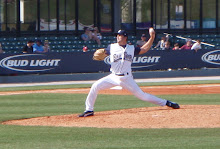
This may or may not come as a shock to most of you, but sign stealing is alive and well in professional, collegiate, and high school baseball. Case and point; every catcher in the big leagues gives multiple signs to the pitcher when telling them what pitch to throw. Especially when there is a runner on second base, it is very easy to see what fingers the catcher is putting down and therefore, even easier to tell the hitter what is coming. But even when there is no one on, you may see the catcher give multiple signs to prevent peering eyes from the other dugout picking up what pitch is coming. So, what are the methods that catcher's use to confuse would-be sign stealers? Here are just a few of the possibilities. Side note..."wiggle" is the universal sign for change-up which involves all four fingers down being wiggled.
1) Negatives - Essentially the catcher will put down multiple signs, none of which will be the pitch he actually wants the pitcher to throw. (e.g. the catcher puts down 2, 3, wiggle, 3 wiggle, 2). You'll notice that the preceding sequence never includes "1" or fastball. That is precisely the pitch the catcher wants. It requires concentration on the pitcher's part, but is generally good at getting the idea across.
2) Plus one Minus one - This technique involves either the innings or number of outs in a game. Essentially, the catcher will throw down any number of signs, with only the last or first sign being the important one. The catch is, if there are no outs, then the actual desired pitch is minus one from the sign given. If there are 1 out, it IS the sign given. And if there are two outs, it is plus one from the sign give. For example, if there is no one out and the catcher gives, 1, wiggle, 2, 2, wiggle, then, assuming the pitcher only has 3 pitches, the desired pitch would be 2 (breaking ball). As you can see, the last sign was a wiggle (or the 3rd pitch the pitcher has). Since there was no one out, you subtract one to get to the desired 2. Another example with innings would be for example, in the 7th inning, the catcher gives , 2, 3, 1, 1, 2, 1 this would mean he wants the pitcher to throw a breaking ball (2). This is because it is the last set of 3 innings which is a "plus one" situation. You take the last sign (1) and add one two it...giving you the desired 2.
3) Follow the 2 - This example is far less complicated but ultimately, just as effectively. Essentially, the catcher will give a sequence and whatever pitch follows the first 2 given is the desired pitch. So for example, if the catcher gives 1, wiggle, 1, 2, 2, wiggle this would mean the catcher wants a breaking ball. As you can see, this is because the first 2 was followed by another 2.
4) Touches- Our last example for today will be one that involves no signs at all. Instead the catcher will use places on his body for the pitch he wants. All the catcher will have to specify is what sign counts (first, second, third or so on) and what means what. So for example, top of the head will be fastball, mask will be curve, and chest will be breaking ball. If the catcher specifies that the second touch is the one that matters, then all he will have to do is touch in the appropriate order to get the desired pitch. For example, if he touches chest, head, mask, head...then this means the catcher wants a fastball.
Of course, there are many other scenarios that some catchers utilize, but these are just a few examples. If you need more, I will happily share more. There is also much more to stopping the running game, but that too will be covered in other posts.
Please post any questions or comments.
Until next time!!

Thank you!
ReplyDelete-unexperienced catcher